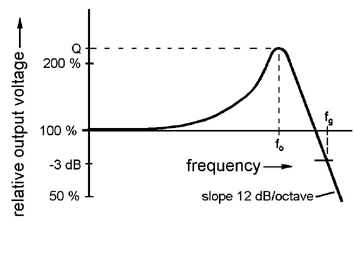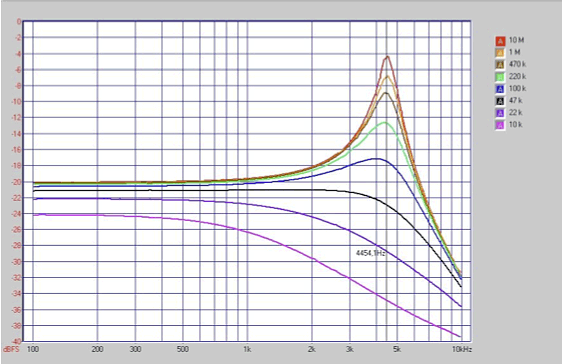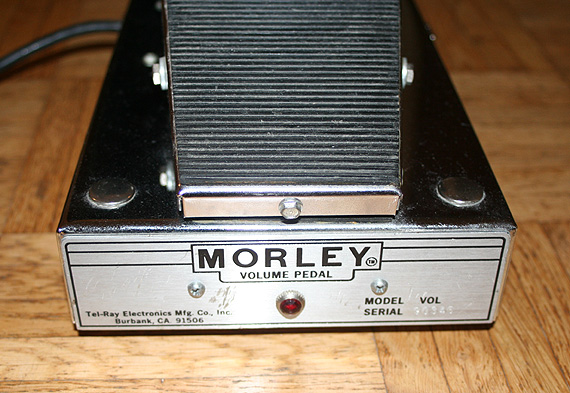In forums I often read questions about different volume pots and the best value they should have. A normal Fender Strat pot has 250 kOhms, but 1MOhms (=1000 k Ohms) is used on Telecasters, while Gibson often uses 500 kOhms. And then there are the no-load pots, so all in all it seems there is some confusion about what to use best, and what effect a different pot value will have.
To start with, pots of all values will do the same in a guitar: adjusting the volume from 0 % to 100 %. Their value has (almost) nothing to do with the resulting highest possible volume, nor has it to do with the ‘volume curve’ that describes how fast the volume changes from 0 – 100% (the so-called taper, which is described with terms like linear or logarithmic). There is only one thing affected by the pot resistance: the height of the pick-up’s resonance peak. So, what on earth is this?
The resonance peak
A guitar pick-up normally consists of a coil around some magnets. Such a construction does not have a linear sound – which means not all frequencies are transduced at the same volume. Instead, there is normally a certain frequency that appears much louder than all others – this peak is called resonance peak, its frequency is the resonance frequency. Note that frequencies higher than the resonance frequency are hardly transduced at all (they become lower with 12dB per octave), see the following image:

The height of this peak and the exact position of that resonance frequency depend on the pick-up’s construction details.Stronger magnets might have a higher resonance peak, while a metal cap of a Gibson humbucker or telecaster neck pick-up dampens the peak. Generally a pick-up with more windings has a lower resonance frequency. It also depends on the guitar cable since a shielded cable – and guitar cables are always shielded – behaves like a capacitor, and a capacitor shifts down the resonance peak. A Fender Stratocaster pick-up for example has its resonance peak at about 7 kHz without guitar cable, but just about 3 or 4 kHz (!) with an average guitar cable – the longer or thinner the cable, the lower the resonance frequency.
If we now put a resistor in parallel to the guitar pick-up – this is called ‘load’ – , it will decrease the height of the resonance peak, in other words it will dampen the peak, see the following graph:

A volume pot divides the signal voltage produced by the pick-up in accordance to the pot position. But no matter which the position the pot is at, the load is always the full resistance of the pot , and thus this value will dampen the resonance peak.
What does it mean to my guitar sound?
Damping the resonance peak means that a part of the treble range is decreased, so we have less treble. Note however that the resonance peak itself is not a ‘natural’ thing but an artefact caused by the pick-up. Seen from this perspective a dampened resonance peak will sound more linear, thus maybe more natural. In fact the resonance peak causes a certain colour to the sound – typically a presence boost that can help to promote clarity, but also can lead to a harsh sound (ever had aching ears from a clean Fender pick-up at high volumes?). So dampening the resonance peak can sound bad or good – depending on the situation and of what you are looking for.
Which value for which sound?
Especially for clear sounds, I like the sweeter sound of the dampened resonance peak better than that harsh, trebly sound. For this reason I prefer a smaller value of the volume pot. Years ago I tried out 1 MOhms pots in a Strat which I found terrible. However, this value might be okay for a Telecaster since the metal cap of the Tele neck pick-up dampens the height of the resonace peak anyway, and dampening it even more might overdo it. On the other hand those typical squealing, microphonic noises of a (sometimes poorly waxed) Telecaster pick-up usually get worse with a high pot value, in fact that whistling feedback will typically start directly at the resonance frequency of the pick-up, so a smaller value might mean less pick-up feedback (which must not be confused with the wanted ‘string feedback’).
The ‘no-load’ pots work like an off-switch at the last part of the rotary. They are intended to be used as tone pot and cannot really be used as volume pot, so let’s forget about these here.

Now forget about all this again because…
The volume pot is not the only part which puts a load (= a resistance parallel to the pick-up) on the pick-up. Also the input resistance of the first device that follows the guitar in the signal chain adds to the total load (and if the first device is a passive device, the input resistance of the next devices will also put more load on the pick-up). To be concrete, both loads will not simply add (in the sense of 250kOhms + 500 kOhms = 750 kOhms) but will follow the formula for resistors in parallel: R-total = (R1 * R2) / (R1+ R2) , with R1 and R2 being the two resistor values. Thus e.g. a 250 kOhms and 500 kOhms will result in a total load of 166.7 kOhms (note that the total is less than the individual values of the two resistors used).
This is the reason why in a real-life set-up the value of the volume pot might become irrelevant. Let’s say the first effect device has an input resistance of 100 KOhms (they normally have a few hundreds, but there are some like a Morley volume pedal, or an Orange Squeezer compressor that are even below 100 kOhms) . Exchanging a 250 kOhms volume pot for a 1 MOhms pot (= 1000 kOhms) will result in a mere change from 71 to 91 kOhms of the total load, and it is this total value that matters.
So, only if you go directly into a high impedance input (high load), e.g. a tube amp typically has 1 MOhms, you will get a major change of the resonance peak height.
Years ago a friend of mine had a ’71 Stratocaster which sounded absolutely great. Besides being very resonant, it sounded sweeter, less harsh, when directly A/B compared to other Strats, going directly into the amp. And we had an original ’62 Strat which for some reason sounded harsher than normal. In fact the volume pots had been replaced on both of them, the ’71 had a mere 100 KOhms, the ’62 had something I measured to be about 800 KOhms.
Conclusion
* The value of the volume pot affects the tone because it has an effect on the height of the resonance peak.
* A smaller value might sound sweeter and not neccessarily duller than a higher value, which might sound harsh in some situations.
* It is the total load that matters – not alone the value of the volume pot. This is why exchanging the pot can have almost no effect, at least it is nothing I use to worry about.

3 thoughts on “The volume pot – what is the right resistance and how does it affect the sound of a guitar pick-up”
The math about the total load might be right (I can’t tell), but the logic isn’t. The idea behind it (that the change in total load is small) is not relevant. It is actually relevant if and only if it results in a perceived change. And your example from the end suggests: Yes, it does. It mattered a lot which tone pots were used.
It’s a logical fallacy proving itself by supplying a different assumption – if people were after a specific total load difference and if only specific total load differences mattered, changing pots wasn’t important. But nobody is asking for that. People want a change in tone, and they’re clearly getting it by changing pots.
So the conclusion of the article is the useful one – if a guitar doesn’t sound good in your setup, maybe swapping out its pots might help. If it sounds dull, maybe a higher value could help. If it sounds shrill, maybe a lower value might help. But its all up for experimentation.
It sounds like you are arguing against yourself. In your Strat example, you specifically state that the pot values are different and they sound different. Then in your conclusions you state that it makes a difference and that it makes no difference. Both can’t be true unless you are picking specific narrow circumstances!